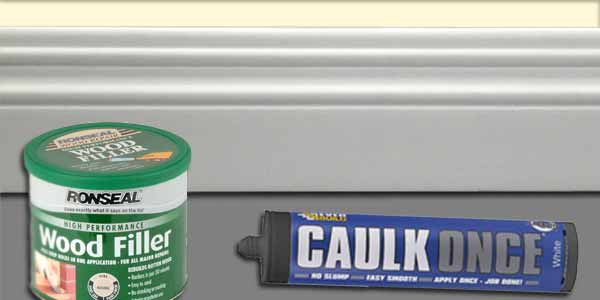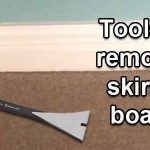When fitting skirting boards, your goal should be achieving the neatest job possible. You don’t want any big gaps, your mitres and scribes should be nice and tight, and ideally, you don’t want any big gaps between the wall and the back of your board.
However, in most cases a small amount of filling will always be necessary. This will be to a greater or lesser extent, depending on how good of a job you did.

Also, some holes are going to be unavoidable. For example, most skirting boards will be fixed with either nails or screws. The screws in particular, will leave reasonably big holes that need filling. Even small pin holes will need a small amount of filler to achieve a nice finish.
So the question is do you use caulk or filler for skirting boards?
To do a proper job, you will need both. Caulk is a great product for sealing gaps prior to painting. This will work particularly well on any small gaps between the wall and your skirting boards. As well as any gaps on internal scribes.
A filler will be much more suitable for filling holes where your fixings were added, and also any small gaps on external mitres.
The reason for this, is caulk shrinks. If you use it to fill holes, it will be very noticeable once the caulk dries. On the other hand a filler is usually applied liberally and once dried it can be sanded to a smooth finish.
Therefore, if you do your filling properly, you can completely hide holes created by things like screw heads. Also, something like a small gap on an external mitre, will look much neater when filler is used. If caulk was used instead, it would likely sink in, and be more obvious.
How to apply caulk to your skirting boards
The main place you will be adding caulk, is the top of your skirting boards. Even if there are no big gaps, a line of caulk will give a nice smooth finish. It will also stop any dirt and debris from getting behind your skirting.
To get started, you will need a tube of decorator’s caulk and a caulking gun. Application is pretty simple. You will need to cut the end of the caulk tube, and also cut a small amount off the end of the nozzle. This should be as small as possible, as we only want a thin line of decorator’s caulk to be released.
Place the caulk in the gun, then begin applying to the joint at the top of your skirting board, where it meets the wall.
To do this, apply gentle pressure to the trigger and slowly move the caulk gun across the edge of your skirting board. This should be at a speed, that gives a consistent small bead of caulk. Don’t worry if you miss a bit, you can always go back to fill any gaps.
The main goal here is to create a small consistent line of caulk. Once this is done, take your finger and gently run it along the caulk. This will give a smooth, seamless finish, ready for decorating.
How to apply wood filler to your skirting
The main place you will use your filler is to fill holes. These holes will usually be created by fixings used to attach the skirting boards. This could be screws, nails, or the smallest holes will usually come from a nail gun.
This is another simple process. You will just need your filler and something to apply it with. The most common option for this is a putty knife, or personally, I like to use a thin wallpaper scraper.
You can scoop filler straight out of the tub. However, I prefer to add some to a little board. An off-cut of skirting is ideal for this. This way you can just scrape the desired amount off the board and any left over can be scraped back on.
To add the filler to holes, take an amount on the end of your putty knife. Whilst applying pressure, run it over the hole. Your goal here, should be a flat layer of filler, that completely fills the hole and sits slightly proud of the skirting board surface.
This extra 0.5-1mm above the surface, will enable you to sand the dried filler to a completely flat finish.
Conclusion
When finishing and filling your skirting boards before decorating, you should use a combination of decorator’s caulk and wood filler. Each one has their advantages for different jobs.
For example, holes filled with caulk are not ideal. They will often sink and be quite obvious. You also can’t sand decorator’s caulk. This means filler is far better for the job of filling holes.
However, when it comes to filling long gaps, such as those at the top of skirting boards, caulk is the perfect tool for the job. Doing this with filler would take forever and it would need sanding afterwards.
Therefore, using both in combination, will give you the perfect seamless finish you are looking for.



